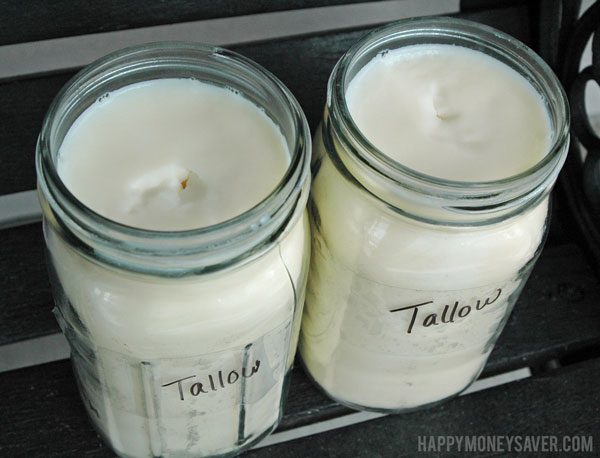
For today’s Happy Homesteading post we are going back in history to learn the long-lost skill of rendering beef tallow fat like many pioneers made & used. Beef tallow was used in cooking as it makes an amazing oil for frying or pastries. They would also use tallow fat for candle making, soap making, moisturizing, keeping cast iron pots from rusting and even for waterproofing leather.
What is Tallow?
“Tallow is the rendered fat of cows, sheep, and other ruminant animals such as deer. It is very solid and waxy at room temperature and can be kept for extended periods without the need for refrigeration. Rendering is the process of gently heating the interior fat tissue, called “suet,” causing the pure oils to melt away from the rest of the tissue.” (Source)Tallow is solid at room temperature, with a texture harder and more waxy than shortening. In fact tallow and lard are rendered the same way, but lard is pig fat slowly melted down and is softer like shortening.
Beef Tallow is a Healthy Fat
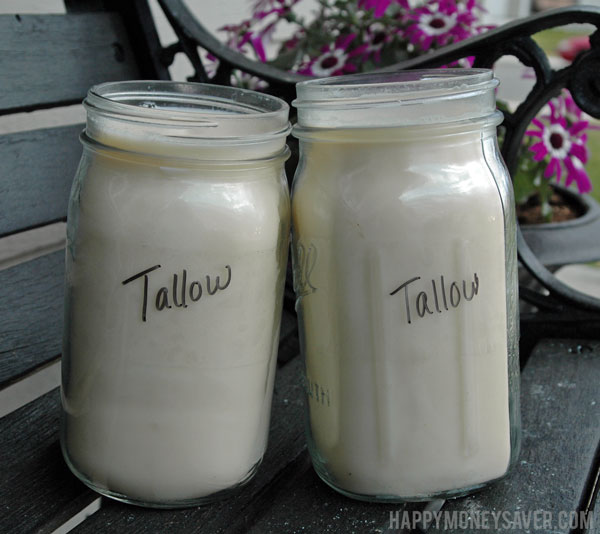
Tallow is the healthy fat that sadly got pushed off the shelves once vegetable oils came around.
Before doing this homesteading series I had honestly never heard of tallow. And when I asked my friends and family about this I just got weird looks. Isn’t it amazing how something that was basically a staple in homes a hundred or two years ago has seemingly been lost or forgotten? After researching I found that beef tallow is actually a very healthy fat full of vitamins and is actually better for you than some of the hydrogenated oils we buy at the stores.
“Tallow is an excellent source of niacin, vitamins B6, B12, K2, selenium, iron, phosphorus, potassium and riboflavin. Grass Fed beef tallow contains high ratio of conjugated linoleic acid (CLA) which is a cancer-resistant agent. Contrary to the popular conception, tallow is good for health as tallow fat is similar to the fat/muscles in the heart. Recent studies have shown that human beings need at least 50% of saturated fats like tallow and lard to keep the heart pumping hale and healthy. Tallow from pasture-raised cows also contains a small amount of Vitamin D, similar to lard. It is also a good source of K2 in its suet form.” (Source)Making Tallow
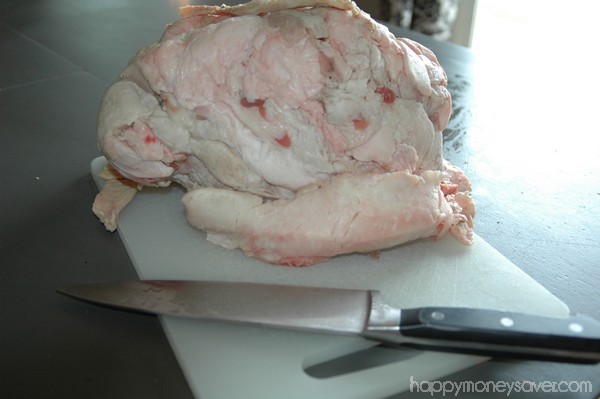
First thing you need is some beef fat. I found a nice local butcher shop, called them up and asked if they had any beef fat. Lucky for me they did and it was only $.67 per lb too. For the nicest and healthiest tallow try to get beef fat from right around the kidneys and preferably from a grass-fed cow. I didn’t ask the butcher at the time I purchased it if this was a grass-fed cow or not, I think I was in shock that I actually found beef fat and that it was so inexpensive. But next time I will ask for sure.
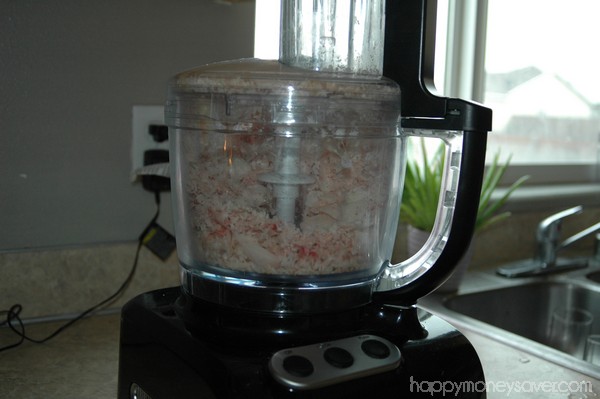
The beef fat I purchased was frozen, so I let it thaw enough that it was still hard but not frozen solid so I could use my food processor to grate it up. If you don’t have a food processor just use a knife and cut the fat into as small of chunks as you can. If there are any pieces of meat you can cut out do it at this stage too.
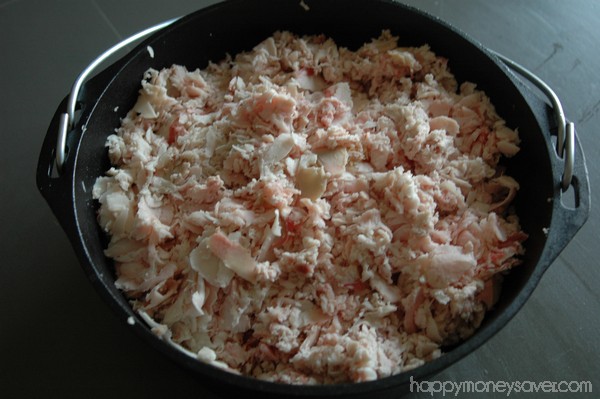
Here is all my beef fat put into my 5 qt. Dutch Oven I purchased. I think there is about 4 lbs of beef fat in there. I filled my pan to the top.
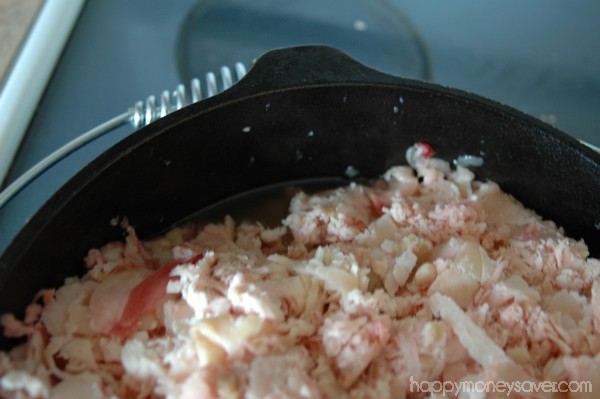
With the heat on low I put the lid on the beef tallow fat and let it start slowly cooking. Here is how it looked after 1 hour. If you had only 1 lb of fat it would look a lot more melted at this stage, but since I have 4 lbs, it is slowly cooking from the bottom.
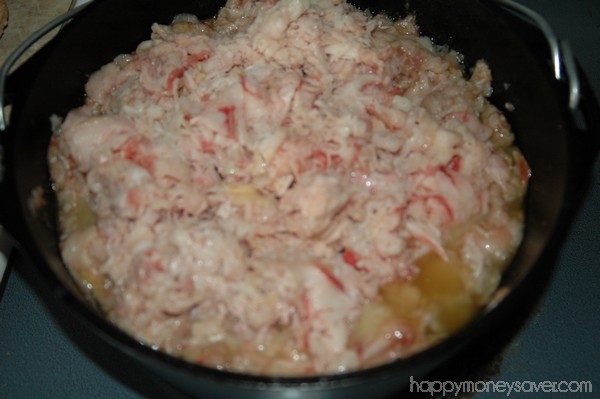
Here it is again after 2 hours. A little more rendered. At this point I took a wooden spoon and mixed the beef tallow fat around a bit. Some people like to take a potato masher and squish it a bit too to help the process along. You don’t want to cook this fast because if it burns it will ruin it all.
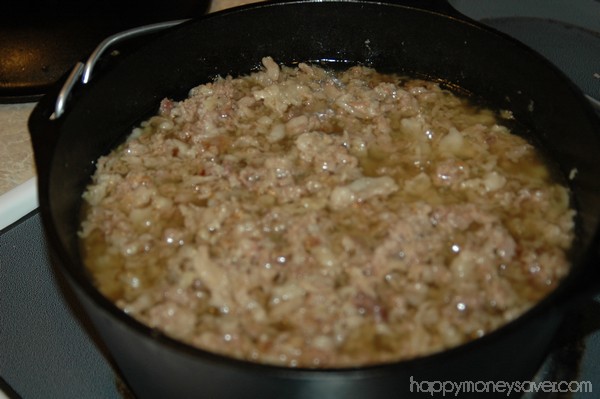
Now its been 4 hours and my house is REALLY starting to smell bad like well..FAT and STINKY OIL. YUCK.

I opened up every window and turned on fans. I can’t stress to you enough how horrible this smelled. At this stage I was just wanting this whole process to be over. I am not kidding. I spent most of the day upstairs just so I couldn’t smell it as much. Then when I did have to go downstairs I actually gagged once from the smell. I am such a baby, aren’t I… 🙂
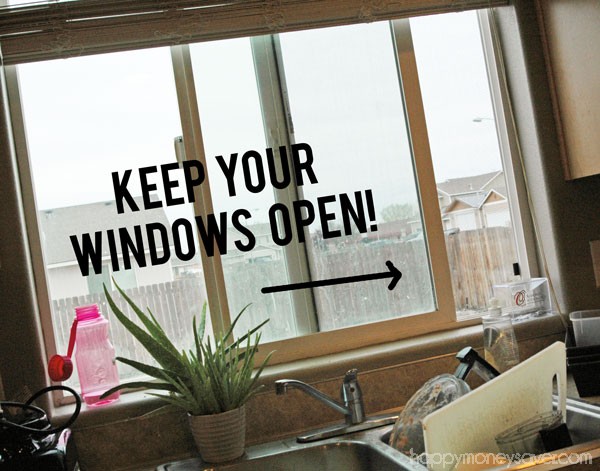
After about 6-7 hours it was all done. You can tell by all the little browned bits cooked till crispy. The Pioneers called these the cracklin’s. They are basically fried bits of meat and grisle. They would sprinkle a little salt on the cracklins and once cool eat them up. I shuddered at the thought after smelling the fat cooking in the air. I actually lost my appetite with the smell in the air.
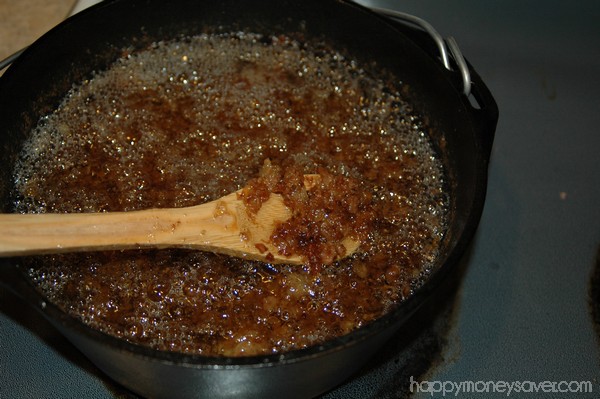
Next is the time to drain all the liquid oil and strain out the cracklin’s. You can use a fine mesh strainer, a paper towel, cheese cloth or what I used: a flour sack towel. I lined the towel over a strainer, which sat over a large bowl.

Then I poured all the hot oil in and strained it. Use oven mitts here, and remember to be safe. This is REALLY HOT oil and can burn you if you are not careful.
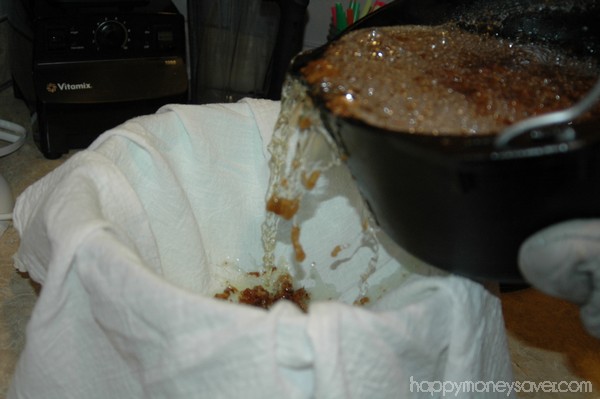
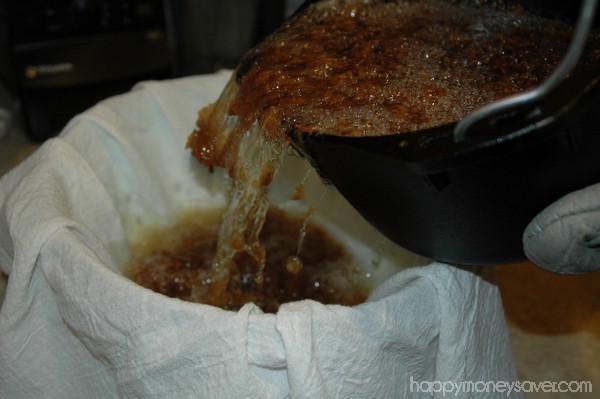

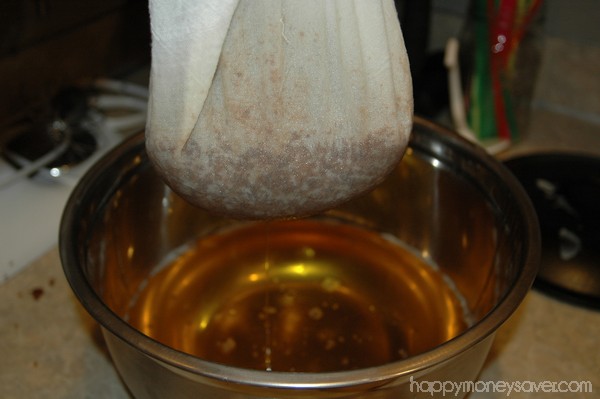
Look at all that lovely yellow liquid tallow left behind after the straining.

It should be a nice yellow color.
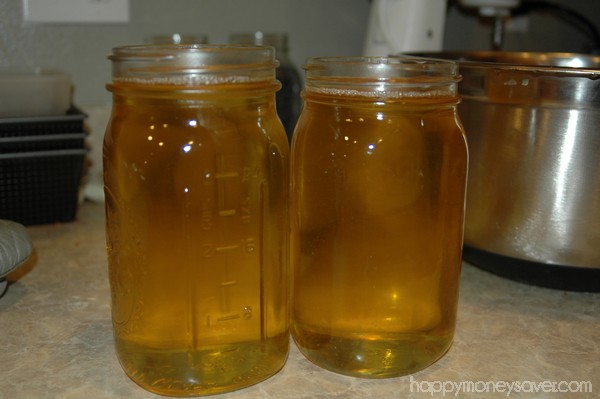
I poured mine into wide mouth glass jars for storage. Then I let it cool all night.
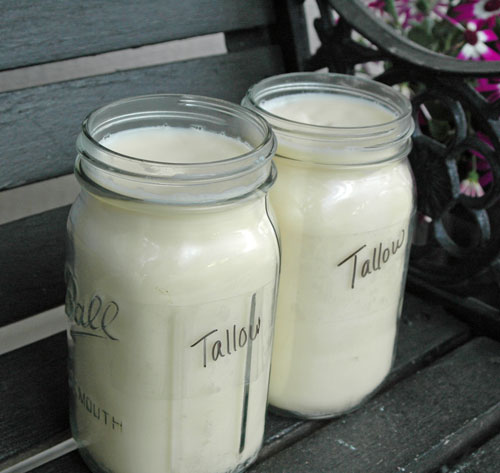
And it turned hard and waxy and white. Isn’t it beautiful??
It was even more beautiful after I deep cleaned my whole kitchen, using vinegar to get the nasty smell out. 😉

Storing Tallow
Beef Tallow is wonderful because as long as you store it in an air-tight container to avoid oxidization it can be at room temperature for up to a year or longer. I have mine in my fridge as it will last even longer there. OR you can pour your tallow fat into ice cube trays and put the frozen cubes into a freezer bag to freeze.
Tallow Soap & Tallow Candles
As many of you might know I made my own homemade soap for the first time last month using a recipe of lye and a variety of store bought oils. I love the soap I made, but I wanted to make soap like the Pioneers and settlers did from long ago using beef tallow. I have heard that homemade tallow soap made from rendering beef tallow is the very best type of soap. It’s strong, its hard and it suds nicely. And I would like to use my own tallow soap instead of using Fels Naptha in my Homemade Laundry Soap recipe as well. So check back, I will be making tallow soap from scratch very soon! Plus I think it might be neat to try to make Tallow candles as well.
So what do you think? Do you have questions? Think this is weird? Please leave a comment with your thoughts!

Ingredients
- Beef Fat preferably from a grass-fed cow and try to get the fat that is from right around the kidneys
Instructions
- Use food processor to grate it up or if you don’t have a food processor just use a knife and cut the fat into as small of chunks as you can.
- If there are any pieces of meat you can cut out do it at this stage too.
- Put beef fat into 5 qt. Dutch Oven, fill pan to the top.
- With the heat on low put the lid on the beef tallow fat and let it start slowly cooking.
- After 2 hours take a wooden spoon and mix the beef tallow fat around a bit. Some use a potato masher and squish it a bit too to help the process along.
- Don’t cook this fast because if it burns it will ruin it all.
- Stir again at about 4 hours.
- After about 6-7 hours it will be done. You can tell by all the little browned bits cooked till crispy.
- Next drain all the liquid oil and strain out the cracklin’s. (Cracklins are basically fried bits of meat and gristle)
- Use a fine mesh strainer, a paper towel, cheese cloth or a flour sack towel and line the towel over a strainer, which should sit over a large bowl.
- Pour all the hot oil in and strain it. It should be a nice yellow color.
- Pour into airtight containers and allow to cool overnight.
- Store it in an air-tight container to avoid oxidization it can be at room temperature for up to a year or longer. You can store it in the fridge as it will last even longer there. OR you can pour your tallow fat into ice cube trays and put the frozen cubes into a freezer bag to freeze.




Comments & Reviews
Adam says
I made tallow from suet in my kitchen as well for soap making. Me and my wife are both sensitive to smells (especially her) and neither of us noticed any foul smell. From my recollection, the smell if any was a light airy oil smell as if someone was cooking a roast or even making bacon. I did use a slow cooker though so maybe that made a difference. Or maybe we just have a different idea of what a bad smell is. In either case I don’t think it should smell bad unless possible the fat had previously spoiled, but from your pictures it looks fresh…
Erin Ballard says
I did this in a crockpot in the house and was threatened by my entire family that if I was ever to do it again, I was out of the family! So now it’s in the garage in the crockpot! Stinks so BAD! But, the finished product is amazing! If you are old enough to remember why McDonald’s French fries tasted so good as a child(I’m 39) and now there just ok, it’s because back in the day, they use to fry in tallow! Amazing oil!
onematchwoman says
I just tried this! I decided to make my tallow into emergency candles, based on your emergency candle recipe. The only thing I would strongly suggest is that you inform your readers that a plastic colander and bowl for the hot tallow will melt! We nearly had a major disaster, but thanks to my hubby’s quick thinking, all was spared. Use an all metal colander and bowl, because the tallow is incredibly hot! Now my kitchen is all clean, and I am excitedly waiting to see how my candles turn out! This was fun, even if my choice in using plastic was somewhat inadvisable! Thanks!
onematchwoman says
PS: The cracklin’s are going to the chickens. They go crazy for them!
Becky says
I accidentially unplugged my crock pot during rendering. Can I put it in a jar and refridgerate and rerender it tomorrow. It probably had another 3 hrs to go before I unplugged it
lmloscar says
ok, we did this yesterday, but have some questions. #1 we did a whole cow’s worth of bones/fat. 80 to 100 lbs. #2 we don’t have a food processor so we cut it = larger pieces than would come out of a food proccessor. Most under 2″ square to start. Still have some large pieces under 1 inch sqauare left in the pot. We’re trying to reheat them because when I squish them more fat comes out. #3 hot liquid tallow was more amber than yellow #4 cooled lard is more tan than white. Do I need to recook the tallow to turn it white? I was afraid I was burning it but now I don’t know, maybe I didn’t cook them long enough. Any input would be appreciated. Thanks. Lynn
lmloscar says
Rereading that, I didn’t make it clear that we made beef broth with the bones. We didn’t include them in the beef tallow rendering process.
Karrie says
Hello Lynn- my tallow was amber at first, but cooled to a whiter color. You don’t need to recook it to turn it white. You might have had more meat in your stuff, that might have affected the color. You used bones in yours? I only used the fat when I rendered mine down. Does it taste good when you cook something with it?
lmloscar says
No, we didn’t use bones in ours. We did two different processes at the same time. Separated the bones to make the broth with and used the fat to render for tallow. Maybe the meat particles did make it darker. It smells and tastes like bacon and isn’t completely solid on the top. I haven’t used any yet. We’ll see. Not neutral flavor as crisco. Not sure what I’m aiming for. Haven’t done it before.
JC says
LOVE THIS!! Some day I plan to make tallow when it either become necessary or get the other myriad of things done I have already planned! Too many projects! One of the things I want to use it for is homemade facial moisturizer. I’ve heard it is better than any other oil or fat for your skin. Someday…….
Thanks so much for sharing your journey! I find it very inspiring!
Steve says
I wonder how long the tallow will last if you seal the jar hot to vacuum seal it?
teresa says
great site, i have been reading up on tallows and such.
saw on another site that to try to clean the tallow (and help with the smell) you need to ‘clean’ it.
which involves putting the hardened tallow back into the pot with equal amount of water, filtering it and then letting it harden and repeating until the water and tallow come out clean.
have not tried that yet but plan to with the 4 pounds of tallow i’ve rendered over the 5 sessions i’ve made tallow.
i do cook my tallow in the kitchen but i have to start it early in the morning (normally done by 11 or 12 as it only takes me about 3 hours to cook it down) and i’ve quite gotten used to the smell. the dogs and i think it smells very nice, actually. nobody else in the family does though.lol.
i filter through coffee filters over a wire strainer then use the cracklin’s in dog treats i make. the dog treats take longer to cut out then the cracklin’s or tallow do to make.hah. but the dogs love them and i know what went into them.
cool site.
let me know how your soap making went and i’ll let you know how mine goes.
teresa says
forgot you have to wait until the mixture of water and tallow harden to separate them… oops.
Danelle says
I just learned how to make lye from wood ashes, and I read that when using homemade lye, it’s vital to use beef tallow to make the soap harden. Without beef tallow the soap suds and cleans nicely but it stays soft and pliable, not very nice to see. I was so thrilled to find your step by step instructions, so I can also get away from using store purchased items to make my laundry detergents. Very cool demonstration. Thank you very much for taking the time to make this instructional!! I can’t wait to try it, and use real beef tallow in my cooking and in my soap making now. I wonder if using beef tallow in candles will produce a greasy aroma as the candle burns, but it’s nice to have a plan “B” if I ever need it. Thanks again!!
Paxmonger says
I grew up with a pioneer grandmother who taught me a lot, but my mom was decidedly a city girl, so it’s been a struggle to retain all of it as I’ve aged. Now that I’m the “grandma” I am striving to regain/remember all that from my childhood, as it’s inevitably healthier, plus good experience. However, most of my family thinks I’m nuts. . .
That said, once I do it, they’re impressed, and my hubby loves saving money. My daughter, the youngest of my three biological kids, seems the most willing to learn. The grandkids are all too little to care
I like the “turkey fryer outside” idea, as you can render a larger amount at once. Since I have friends who are Muslim, I’d go with the beef rather than pork. Don’t want to gift them with homemade soap made with pork! Not that I’ve tried soap yet because hubby and I live in a tiny 1br. apartment with no room to do much, but I’m going to!
Please share the recipe for homemade wood ash lye! That would be skilz! Wish I knew someone with a big farm who would like another family to move on the property and join them in the lifestyle. No one in our family has enough money to buy one, plus it would be amazing to have mentors 🙂 Great posts, thanks for sharing!
Marlene says
We raised two “beef” this year and we kept all of the fat and it is in the freezer. I have always used it to make suet for the birdies. Hummm…this time I am going to make tallow and some soap and possibly some candles. Nice to read all the comments. Love your real approach to making things the “old” way. Absolutely love it. I do make the laundry soap…works great. The dishwasher soap doesn’t seem to get the dishes clean. I use vineager for the rinse. Any suggestions? I have always thought the rendering of the fat to be really stinky too. I plan on doing it outside this year. Just have to keep an eye on it.
Gene says
I thought rendering was supposed to be done outside. That’s how I did it. I used a Coleman gas camp stove. Worked fine. But I never did strain it. I added water equal to the amount of what was left after cooking several hrs., stirred it together good, and let it sit over night. The next day I was able to lift the slab of tallow off. Wouldn’t consider doing it indoors.
Shelley says
I remember making bear tallow with my dad when I was a kid… glad I found you! Not only for the good ideas and advice, but for the memories! 🙂
Karrie says
Oooh…bear tallow. I wonder what that tastes like…cool!
Holly says
Hi! I’m assuming the towel you used for filtering had to be thrown away? To simplify things I will use an old (but washed) t-shirt so I can use it as fire starter for the next campfire. I do the same thing when rendering beeswax—use rags and t-shirts so I’m not buying cheesecloth etc.
Karrie says
Nope, I just hand washed it in my kitchen sink with laundry detergent.
Cyndi says
I just happened upon your site today and can not stop reading. It so brings back memories of my childhood. I live on a small farm and once a year we butcher beef, hogs etc and so much goes to waste. Not this year I’m not sure when I became in my words so unmotivated. Maybe working 60 hours a week and trying to raise my children and keep the farm going I just got tired. Now that the children are all married and gone I find myself still working a 40 hour week, but trying to find things to fill my time. I have a huge garden and can most every thing I can from vegetables to soups to meats always looking for more things to do back to basics. Keep up the excellent work.
Liz says
I so enjoy reading your experiences with being a resourceful lady!
I have rendered beef fat and also have used bot just fat and suet… the suet definately makes a nicer tallow.
I make goats milk soap, milk from my own little goats that I milk by hand… no machines here.
I do use beef tallow as well as lard in my soaps, definately a nicer feel to the soap than only using plant based oils, I personally do not like the feel of a castile type soap made from only olive oil and coconut oil… too slimey feeling.
I was raised in a poor, self sustaining home and was taught that Waste not, Want not and every bit of everything raised or hunted was used and to this day, though I have more than what my parents did, I still follow that philosophy.
Keep up the good work, you are a role model for those who want to learn the pioneer ways.
Kelly says
HI, I am in love with your website!! I find myself on it when I should be working!!! Lol. I was wondering if you have had a chance to make candles from tallow?
Dianne Andrews says
your fat looks like not-grass fed fat to me. Grass fed is very yellow. I’ve got some in my freezer I should really melt down one of these days!
Amanda says
I use any rendered fat for soap and it all works great. I use rabbit fat-we raise our own meat rabbits-it looks and tastes just like lard from a pig. I also make lard, a local pig farmer (organic) gives us fat to render. I know that in pioneer days tallow was used for soap, lard for cooking but that was because tallow tastes yucky to a lot of people. Lard is still fabulous for soap! I personally like it best for shaving my legs as its a bit softer. The tallow soap is better for laundry.
Kelly says
Hi Amanda, Would u b willing to share your soap recipe that u use to shave with? We just had our hogs butchered and I kept the fat! I am so excited! Lol
Malin says
Hi, have you tried to make soap and candles yet? 🙂
Monica says
I’m so impressed with you and your thirst for knowledge. I found your blog quite by devine accident and have thoroughly enjoyed reading the archives. I have to commend you on your willingness to personally respond to almost every comment. Thank you for your “breath of fresh air attitude ” towards life. I’ve bookmarked your site and look forward to keeping up with you. If you are ever in Virginia Beach look us up, I’d love to meet you! -Monica (Mom of five)